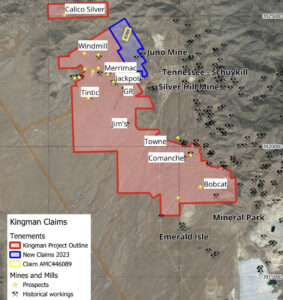‘Much larger than anticipated’: New claims extend Riedel’s rich Silver Hill-Juno trend at Kingman
Mining
Mining
Special Report: Riedel Resources has expanded its Kingman gold project in northwest Arizona after pegging new mineral claims contiguous to the existing claim package.
Historical mining has occurred throughout Mohave County in northwest Arizona from the 1880s until 1942 when non-essential gold mines were ordered to cease operations by the War Production Board.
Exploration at the Kingman project area didn’t resume until 2019, when Riedel Resources (ASX:RIE) commenced an 11-hole diamond program targeting shallow, high grade gold-silver epithermal style mineralisation.
The company has now drilled 240 drill holes totalling ~18,000m across the project with a 5,000m resource infill drilling program in 2023 at the Tintic deposit returning shallow hits topping out at 1.52m at 13.8 grams per tonne (g/t) gold, 223g/t silver, 4.6% lead and 0.56% zine from 67.06m. A maiden resource is due next month.
More recently, rock chip sampling returned up to 678g/t silver at the Calico Silver prospect, which consists of several historical workings that have not been subject to modern exploration.
The new claims cover ~152 hectares and sit along the northwestern extension of the Silver Hill-Juno trend, considered to be highly prospective for high-grade gold and silver mineralisation.
Historical production from the Juno mine averaged 5g/t gold and 208g/t silver.

Kingman project area with existing claims (red) and new claims (blue). Pic: Supplied (RIE).
Additionally, the potential to discover additional mineralisation analogous to those already identified in Riedel’s claim area such as Tintic, Merrimac and Arizona-Magmam is enhanced by the WW2 ban on gold mining and the limited modern exploration since.
“The new claims recognise that the Kingman project mineral system is very large, much larger than anticipated, with multiple high-grade mineralised trends throughout the district that are untouched by modern exploration methods,” chief executive officer David Groombridge said.
“The new claims enable Riedel to further develop on from our success at Tintic and to build on our already dominant land position in the project area.
“The new claims extend north and west of the neighbouring historical Juno mine which mined ~7,088t for 1,207oz of gold, 37,675pz of silver, 251,000lbs of lead, 207,000lbs of zinc and 6,000lbs of copper.
“The Juno mine represents only one of the historical workings within the many highly prospective structural corridors across the Kingman project and we are excited to advance exploration into these new areas, increasing our geological knowledge to make new discoveries.”
RIE remains focused on delivering a maiden resource estimate for the Tintic deposit in December, which will help underpin a preliminary economic study that will in turn pave the way for the submission of mining permitting with relevant authorities in Q2 2024.
Additionally, a regional soil program is planned for 2024 across the entire Kingman Project area which will incorporate reconnaissance geology mapping and sampling within the newly-pegged Juno Trend.
Targets identified will undergo detailed work programs that will culminate in drill permitting with the Bureau of Land Management (BLM) with drilling of priority targets to occur in 2024.
This article was developed in collaboration with Riedel Resources, a Stockhead advertiser at the time of publishing.
This article does not constitute financial product advice. You should consider obtaining independent advice before making any financial decisions.